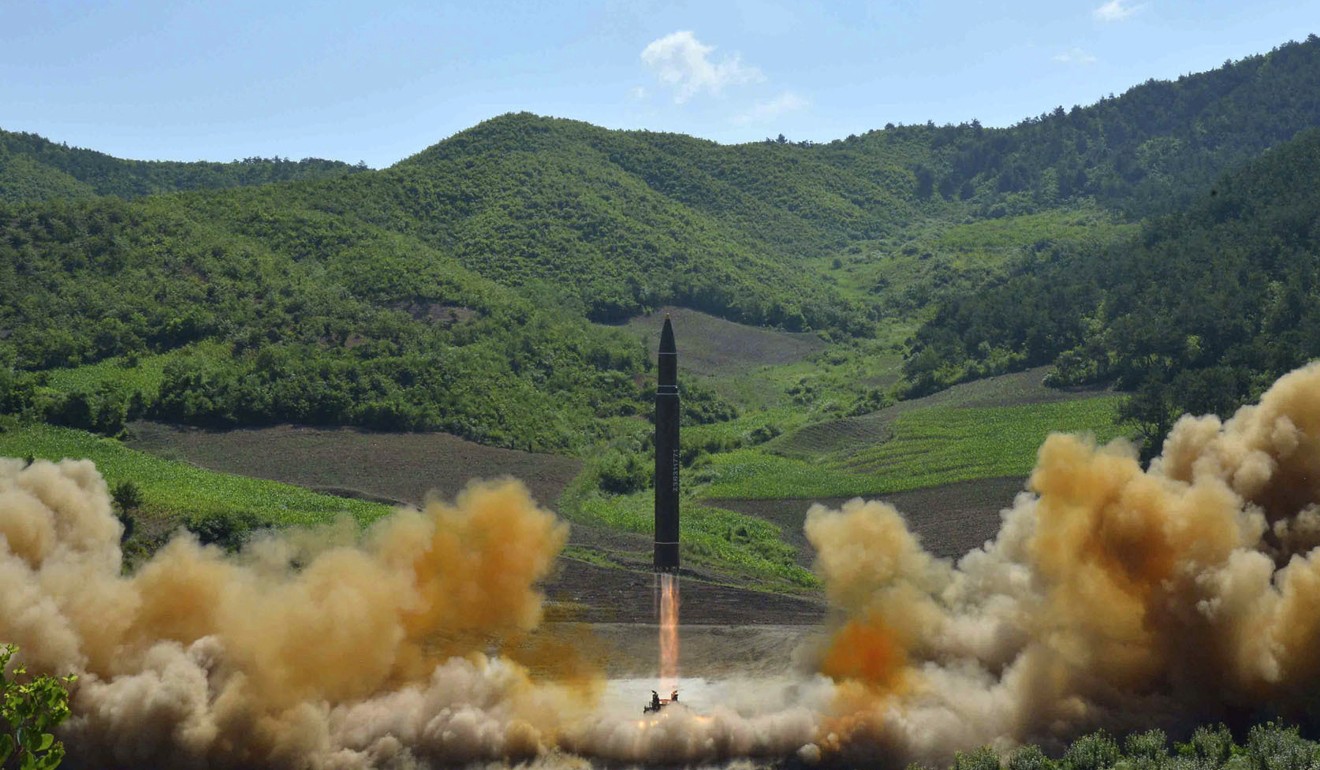
North Korea heralds ‘final step towards nuclear state able to strike anywhere’
After Pyongyang claims successful launch of intercontinental ballistic missile, China and Russia call on US and South Korea to suspend military drills in exchange for no further tests
North Korea on Tuesday said it had successfully tested its first intercontinental ballistic missile, catching military experts off-guard and ratcheting up pressure on its Asian neighbours to take a harder line against the hermit nation.
China, Pyongyang’s main ally, issued a joint statement with Russia that calls for a halt to missile tests in exchange for the US and South Korea suspending their large-scale military exercises.
The launch comes at a sensitive time in global affairs. Chinese President Xi Jinping is due to meet US counterpart Donald Trump at a G20 summit in Germany in the coming days, and South Korean leader Moon Jae-in wrapped up a visit to the White House last week.

The missile was launched at 9.40am and flew about 933km, reaching an altitude of 2,802km, before falling into the sea inside Japan’s exclusive economic zone after a 39 minute flight, the North’s official media reported.
The launch was tracked by the US and Japan, which said the missile reached an altitude that “greatly exceeded” 2,500km.
It appeared to be the most successful missile test yet by North Korea, flying higher than the 560km recorded by Seoul in the previous test carried out in May.
Pyongyang said the success of the ICBM – which it calls the Hwasong-14 – marked the “final step” in creating a “confident and powerful nuclear state that can strike anywhere on Earth”.

The Russian and Chinese foreign ministries made the proposal in a joint statement after talks between President Vladimir Putin and Chinese President Xi Jinping in Moscow on Tuesday.
“The situation in the region affects the national interests of both countries,” the statement said. “Russia and China will work in close coordination to advance a solution to the complex problem of the Korean peninsula in every possible way.”
Andrei Chang, founder of military affairs magazine Kanwa Asian Defence, said he was surprised by Pyongyang’s progress in its missile programme. “Now there is only one question remaining – whether the missile will be equipped with a nuclear warhead one day. North Korea’s missile experts are very smart, and it’s possible based on the existing progress and capability,” Chang said.
Based on the missile’s similarity to China’s own ICBMs with a range of more than 6,000km, he estimated it could strike Alaska, but the lower 48 states as well as Hawaii would be out of range.
China’s foreign ministry said it opposed the test and called for restraint by Pyongyang, as well as calm from all sides. “China urges the DPRK to refrain from acts that violate UN Security Council resolutions so as to create necessary conditions for resuming dialogue and negotiation,” ministry spokesman Geng Shuang said, using the North Korea’s official name.

One Chinese foreign affairs expert said North Korean leader Kim Jong-un might have intended the test as a reminder to China and the US of Pyongyang’s presence ahead of Xi and Trump’s meeting in Hamburg.
Kim might also be trying to sow tension between Beijing and Washington over how to contain the North’s weapons programme, according to Sun Xingjie, a professor at Jilin University. Disagreement between the two sides could see the US move closer to Japan and South Korea, which in turn would push China towards North Korea, he said.
Trump has grown increasingly impatient over the deadlock in resolving the nuclear crisis, and blamed China. He discussed the issue with Xi by phone on Monday, but both sides failed to announce any progress beyond reiterating their commitment to a denuclearised Korean peninsula.
Trump took to Twitter after the launch, writing: “Hard to believe that South Korea and Japan will put up with this much longer. Perhaps China will put a heavy move on North Korea and end this nonsense once and for all!”
Alexander Gabuev, a senior associate and chair of the Russia in Asia-Pacific programme at the Carnegie Moscow Centre, said he expected Sino-Russian ties to continue to grow, but there were limits. “It increasingly appears the Trump administration will be tough on many issues which constitute China’s core interests, and the US will be unable to improve relations with Russia ... However, there are limits – Beijing and Moscow don’t want to enter a military alliance relationship.”
Additional reporting by Associated Press and Reuters


